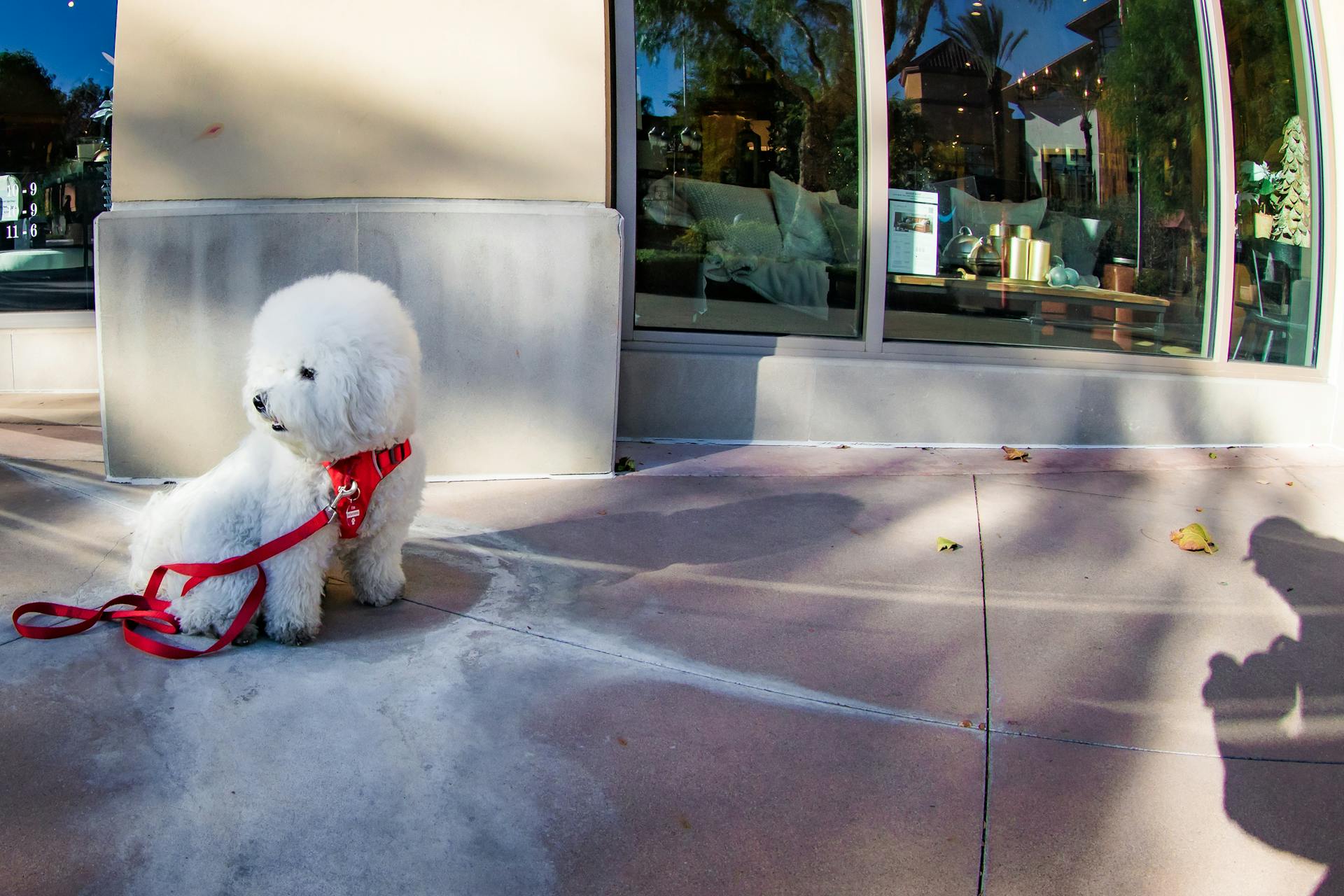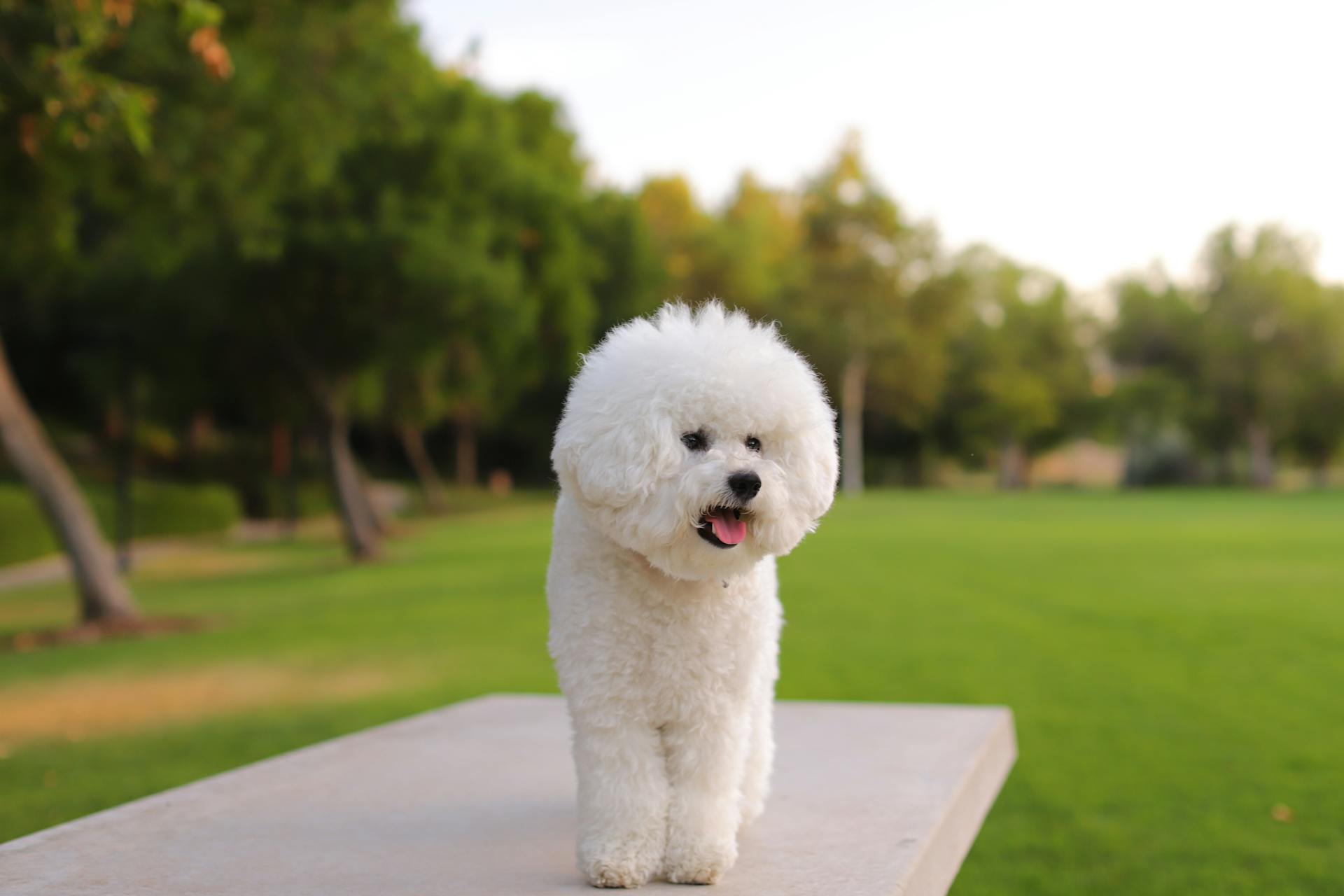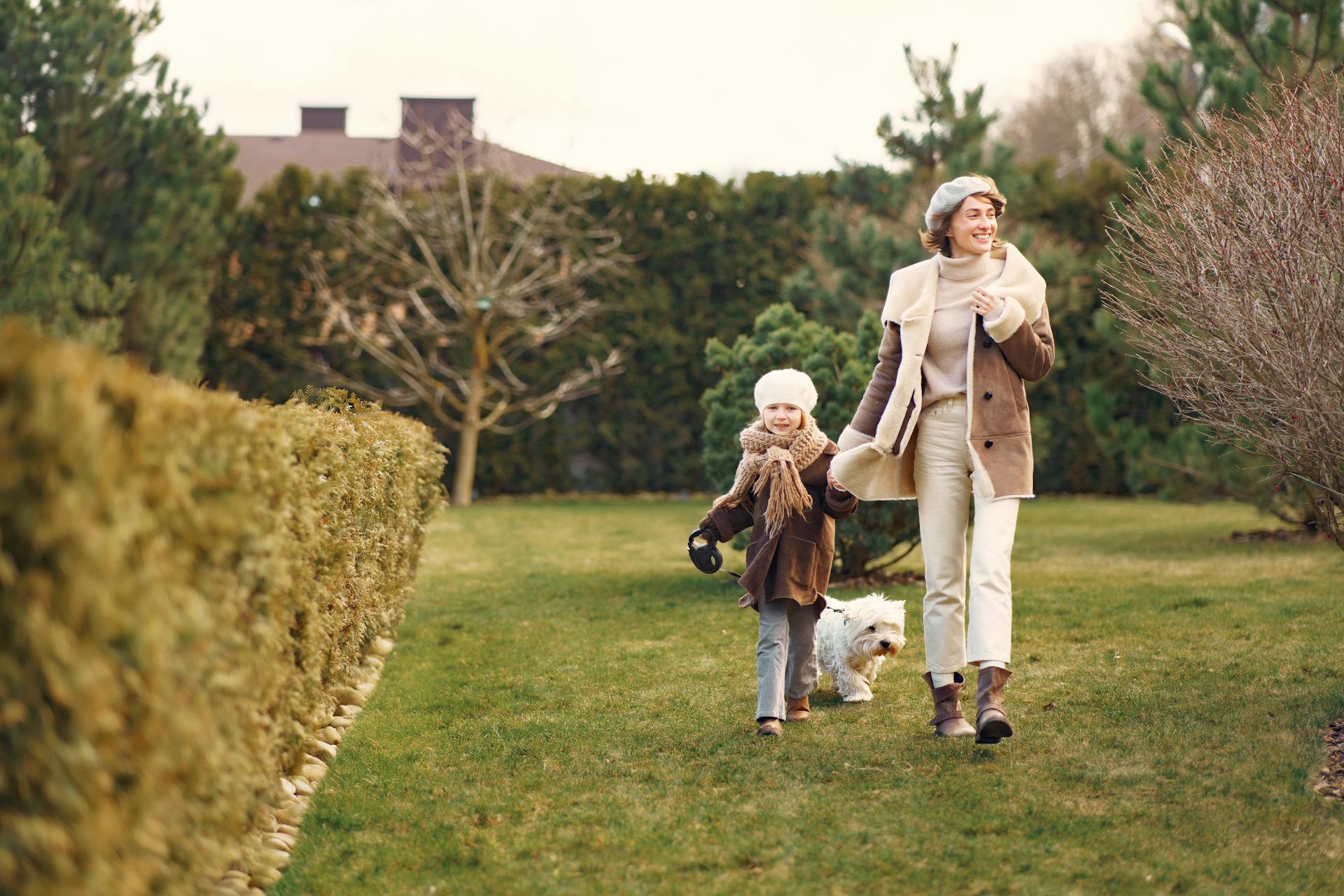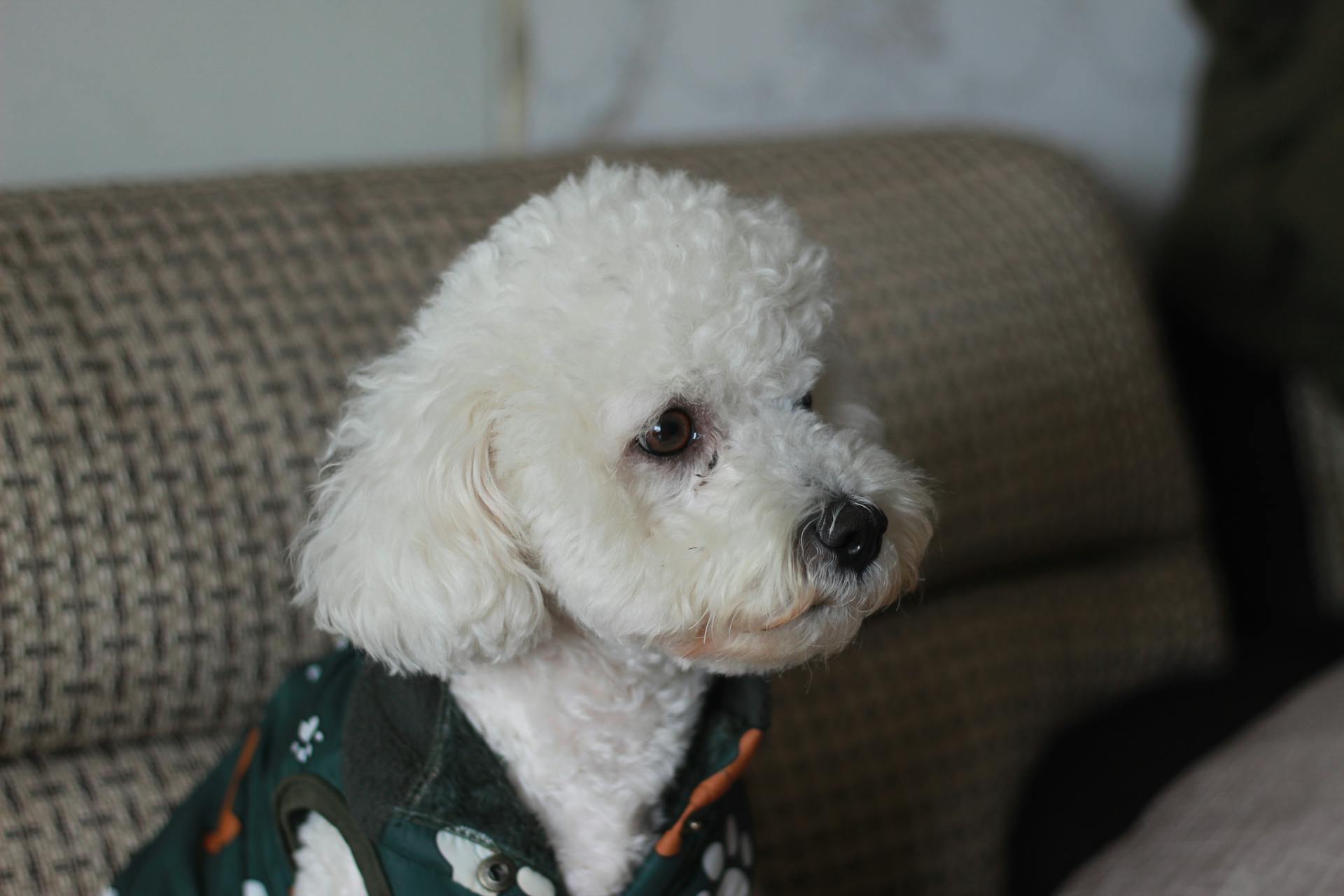
Bichon Frise tear stains can be a real challenge for owners. They're caused by the pigmentation in the tears of Bichon Frises, which can leave unsightly stains on their white coats.
These stains are more noticeable on Bichon Frises because of their white fur, making them seem like they're crying. Bichon Frises have a unique tear duct structure that makes them more prone to tear stains.
To prevent tear stains, it's essential to keep your Bichon Frise's face clean. Regularly wiping their face with a damp cloth can help reduce the appearance of stains.
You might enjoy: Are Bichon Frise Good Dogs
What Are Tear Stains?
Tear stains are a common issue for Bichon Frise owners, and it's essential to understand what they are.
Tear stains are caused by the pigmentation of the tears, which can be more pronounced in white-coated breeds like the Bichon Frise.
The tears of a Bichon Frise contain a pigment called porphyrin, which can cause unsightly stains on the fur.
These stains can appear as brown or reddish-brown marks around the eyes.
The frequency and severity of tear stains can vary depending on the individual dog's anatomy and genetics.
Bichon Frises are prone to tear stains due to their shallow eye sockets and long eyelashes that can cause the tears to flow over the eyes.
Regular cleaning and maintenance can help reduce the appearance of tear stains.
However, some Bichon Frises may be more prone to tear stains than others due to their genetic makeup.
It's not uncommon for Bichon Frises to have tear stains that are more noticeable during certain times of the year, such as when the air is dry or when they're exposed to strong winds.
Causes and Prevention
Bichon Frise tear stains are a common issue for many owners, and understanding the causes can help you prevent them. Bichon Frises are prone to tear stains due to their brachycephalic face shape, which causes tears to accumulate on their face.
The excess of tears results from eye irritation or from your dog's eyes being unable to drain tears properly. This can be due to various reasons such as glaucoma, conjunctivitis, eye infections, or irritant exposure.
To prevent tear stains, keep the hair around your pet's eyes trimmed short. Regular face cleaning is also essential, and you can use a slightly damp washcloth or cotton ball to clean the area around the eyes at least twice a day.
Some supplements claim to reduce the amount of porphyrin in the tears, which should lead to less dyeing of the fur. However, what works well for one pet may not work for another, so it's essential to experiment and find a routine that works for your Bichon Frise.
Here are some breeds that are prone to tear staining due to their brachycephalic face shape:
- Bichon Frise;
- Boston Terrier;
- Cavalier King Charles Spaniel;
- Boxer;
- French Bulldog;
- English Bulldog;
- Pug;
- Staffordshire Bull Terrier;
- Shar Pei;
- Chow Chow;
- Dogue de Bordeaux;
- Bullmastiff.
In addition to these breeds, long-haired dogs and dogs with lots of hair around the nose and eyes can also experience irritation and tear staining.
Removing and Preventing Stains
Removing and preventing stains on your Bichon Frise is a must, especially those pesky tear stains. Always rule out underlying medical conditions before attempting to remove tear stains, and consult your veterinarian for advice.
You can use over-the-counter eye wipes, eye washes, and other at-home remedies to clean your dog's tear stains. Optixcare Dog & Cat Eye Cleaning Wipes, Petpost Tear Stain Wipes for Dogs, and Miracle Care Eye Clear Cleaning Pads for Dogs & Cats are just a few options.
To prevent tear stains from developing, keep the hair around your pet's eyes trimmed short. Regular face cleaning can help, using a slightly damp washcloth or cotton ball to clean the area around the eyes at least twice every day.
Some supplements claim to reduce the amount of porphyrin in the tears, which should lead to less dyeing of the fur. Angels' Eyes Natural Chicken Flavored Soft Chew Tear Stain Supplement for Dogs & Cats, NaturVet Tear Stain Plus Lutein Soft Chews Supplement for Cats & Dogs, and VetClassics Tear Stain Soft Chews Dog & Cat Supplement are a few examples.
Here are some products you can use to remove and prevent tear stains:
Remember to always wipe away from your dog's eye and avoid getting any product in the eye. And don't forget to dry the face with a clean towel after cleaning.
Treatment and Prevention Methods
Bichon Frise tear stains can be a real nuisance, but there are some effective treatment and prevention methods to try. Regular face cleaning is a must to prevent staining, so keep the hair around your pet's eyes trimmed short and clean the area around the eyes at least twice a day with a damp washcloth or cotton ball.
Using a contact lens cleaning solution containing boric acid can also help, but be sure to only clean around the eye, not in it. Some supplements like Angels' Eyes Natural Chicken Flavored Soft Chew Tear Stain Supplement for Dogs & Cats, NaturVet® Tear Stain Plus Lutein Soft Chews Supplement for Cats & Dogs, and VetClassics® Tear Stain Soft Chews Dog & Cat Supplement may also help reduce tear stains by reducing the amount of porphyrin in the tears.
If your Bichon Frise is experiencing tear stains due to an underlying health issue, it's essential to consult with a vet or eye specialist to determine the cause and form a treatment plan. This may involve medicated drops, antibiotics, surgery, or lifestyle changes such as more exercise, a change in diet, or switching to a non-plastic food bowl.
A Veterinary Guide
If your dog is experiencing epiphora, it's essential to see a vet or eye specialist to determine the cause. Your vet will form a plan to treat the condition, which may involve medicated drops or antibiotics for infections.
A simple eye flushing may be enough to reduce tear production if the cause is an irritant. Some vets may recommend a supplement to aid with epiphora, while others suggest using wipes specifically formulated to remove tear stains.
If the cause of epiphora is allergies, you may need to give your dog an antihistamine or make changes to their diet. Stress or a poor diet can also cause epiphora, and your vet may recommend lifestyle changes, such as more exercise and a non-plastic food bowl.
Readers also liked: Does Tap Water Cause Tear Stains in Dogs
Don't switch to a grain-free diet without talking to your vet, as it may be linked to certain heart conditions. Some people swear by adding apple cider vinegar to their dog's food to help with epiphora, but be sure to consult your vet before making any changes.
If your dog develops yellow or bloody fluid around their snout, it's likely due to an infection, and your vet may prescribe antibiotics. Your vet may also recommend a physical examination to rule out any underlying health conditions that require urgent care.
Here's a quick rundown of common causes of epiphora and their potential treatments:
Remember, it's always best to consult with your vet to determine the best course of treatment for your dog's unique situation.
How to Prevent and Treat Them?
Preventing tear stains is a must for any dog owner. Regular face cleaning is key, so keep the hair around your pet's eyes trimmed short.

Cleaning the area around the eyes at least twice a day with a slightly damp washcloth or cotton ball is a good start. You can also use contact lens cleaning solution that contains boric acid to clean around (not in!) the eye.
Some supplements claim to reduce porphyrin in tears, which can lead to less dyeing of the fur. Try Angels' Eyes Natural Chicken Flavored Soft Chew Tear Stain Supplement for Dogs & Cats, NaturVet Tear Stain Plus Lutein Soft Chews Supplement for Cats & Dogs, or VetClassics Tear Stain Soft Chews Dog & Cat Supplement.
Remember, what works for one pet may not work for another, so be patient and try different methods.
Check this out: Bichon Frise Not Groomed
Frequently Asked Questions
How do you get rid of Maltese tear stains?
To remove Maltese tear stains, mix 1 part hydrogen peroxide with 10 parts water and apply it under your dog's eyes using a cotton ball. This simple solution helps to lift and remove unsightly tear stains, leaving your dog's face looking clean and healthy.
How to keep Bichon Frise white?
To maintain a Bichon Frise's signature white coat, regular brushing (at least twice a week) and frequent bathing are essential. This helps prevent dirt and stains from setting in and keeps their fur looking its best.
Sources
- https://www.petmd.com/dog/general-health/dog-tear-stains
- https://www.akc.org/expert-advice/health/tear-stains-prevent-and-clean/
- https://leospetcare.com/services/pet-parent-library/blog/veterinary-guide-tear-stains/
- https://dogtime.com/dog-health/51621-tear-stains-dogs-eyes-mean
- https://petcube.com/blog/dog-tear-stains/
Featured Images: pexels.com


